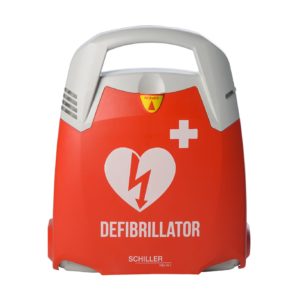
In Australia, more than 30,000 cardiac arrests occur every year, with fewer than 10% surviving to leave hospital (Ambulance Victoria, 2016).
In fact, 177 Victorians were saved in a year due to first aiders starting CPR. In a cardiac arrest the heart is no longer pumping, blood flow stops, the casualty loses consciousness and will not be breathing normally. This person will die, unless within a short period of time blood flow is restored. Immediate cardiopulmonary resuscitation (CPR) will restore some blood flow.
For a short period of time, the non-pumping heart may have an abnormal rhythm, ventricular tachycardia (VT) or ventricular fibrillation (VF) which may be “shocked” by defibrillation (a type of electric shock) back to a normal pumping rhythm.
Rescuers (professional, trained layperson or untrained person) cannot tell by looking at a casualty whether the casualty has a “shockable” rhythm or a “non-shockable” rhythm (where defibrillation will have no benefit for the casualty).
One of the functions of an AED is to determine whether the casualty has a “shockable” or “non-shockable” rhythm. The time to defibrillation is a key factor that influences survival. For every minute defibrillation is delayed, there is approximately 10% reduction in survival if the patient is in cardiac arrest due to VT or VF, (shockable rhythms). CPR alone will not save a person in VT/VF, so a defibrillator should be applied to all casualties as soon as available so that a shock can be delivered if required. The development of easy to operate AEDs has led to defibrillation being included in basic life support teaching. AEDs can accurately identify the cardiac rhythm as “shockable” or “non-shockable” and provide verbal and visual prompts of the next steps (e.g. shock advised, or no shock advised, and continue with CPR).
Many cardiac arrest patients can be saved if persons nearby immediately recognise they are in cardiac arrest, call Triple Zero (000) for an ambulance, perform CPR and use an AED.
Each of these stages “is a link” in a “chain of survival” that provide the best chance of survival.
Minutes count and members of the public along with first responders represent the front line in resuscitation. Defibrillators (AEDs) are easy to use, compact, portable and very effective. They are designed to be used by lay persons; the machines guide the rescuer through the process by verbal prompts and visual prompts. They are safe for the casualty/victim and will not allow a shock to be given unless it is required. They are designed to be stored for long periods without use and require very little routine maintenance.
In Australia, AEDs have been installed in many busy public places, workplaces, or other areas where the public might have access. The intention is to improve early access to defibrillation. This strategy of placing AEDs in locations where they can be used by a lay person is known as Public Access Defibrillation (PAD). Allowing the use of AEDs by members of the public without prior formal training may be lifesaving. However, the use of an AED by trained members of the public and professional responders is encouraged.
Purchasing this life saving equipment in a work place is vital.
There are several factors to consider when contemplating purchasing and installing an AED, some of these considerations. AEDs should be placed or stored where they are most likely to be needed. They must be accessible with a minimum of delay.
All persons working at the site need to be aware of their purpose and location, and the steps to be taken should someone suffer cardiac arrest. This will include calling Triple Zero (000) for an ambulance service and activating the organisation’s emergency response plan – i.e. to commence CPR on any casualty who is unresponsive, and not breathing normal.
We would like to thank the Australian Resuscitation Council for this information.


Leave a Reply
You must be logged in to post a comment.